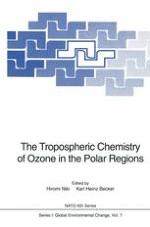1993 | OriginalPaper | Chapter
Heterogeneous Reactions of Chlorine Compounds
Authors : Cornelius Zetzsch, Wolfgang Behnke
Published in: The Tropospheric Chemistry of Ozone in the Polar Regions
Publisher: Springer Berlin Heidelberg
Included in: Professional Book Archive
Activate our intelligent search to find suitable subject content or patents.
Select sections of text to find matching patents with Artificial Intelligence. powered by
Select sections of text to find additional relevant content using AI-assisted search. powered by
Major tropospheric sources of HCl are the intrusion of acids [HNO3, Martens et al., 1973, and H2SO4, Hitchcock et al., 1980] into sea spray aerosol [Cadle and Robbins, 1960], the direct release of HCl from coal power plants [Lightowlers and Cape, 1988], the release of Cl2 [Hov, 1985], a photolytic source of Cl atoms which react with hydrocarbons to form again HCl, and a minor source is the photodegradation of chlorinated hydrocarbons [Behnke and Zetzsch, 1988, 1989a, and Becker and Zetzsch, 1989]. Subsequently, the slow gas-phase reaction of OH radicals with HCl is expected to form atomic Cl. These processes have been reviewed by Cicerone [1981], Warneck [1988], Friend [1990] and Keene et al. [1990] and are leading to global levels of atomic Cl around 103cm−3 [Singh and Kasting, 1988], provided that the level of HCl is around 1 ppb [Vierkorn-Rudolph et al., 1984, Bächmann and Fuchs, 1987, Keene et al., 1991, although an upper limit of 0.25 ppb has been observed by Harris et al., 1990 in the marine boundary layer].
